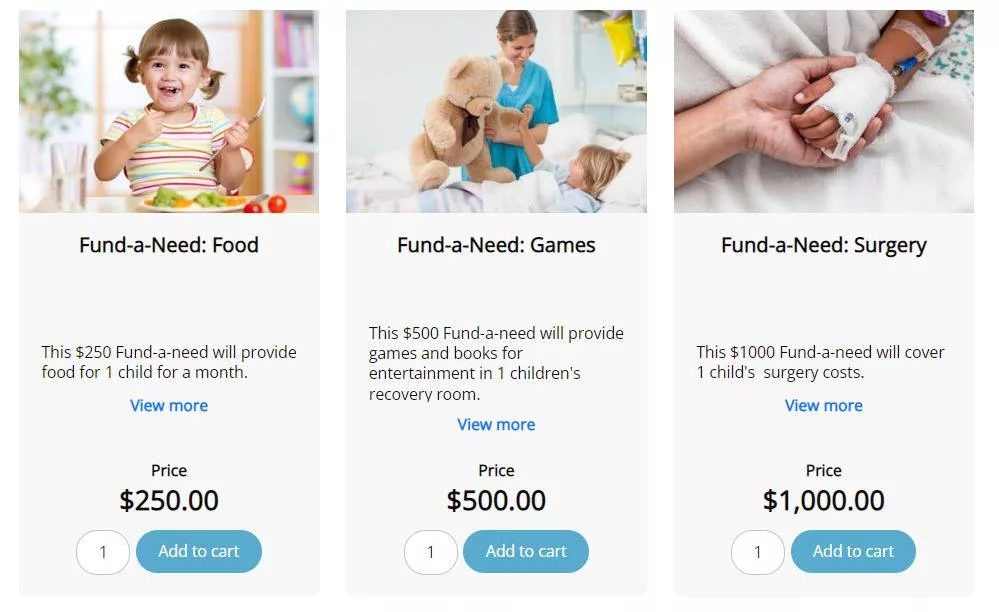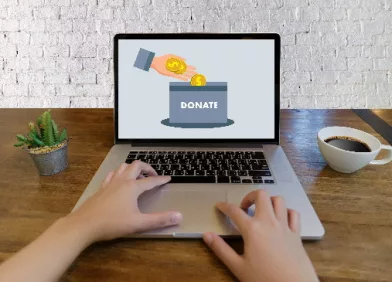
Donation tiers or donation levels are a great way to show your donors where their money is making an impact. Keep reading to help your organization understand the countless benefits of donation tiers and how to create effective and realistic donation levels in four simple steps.

What We’ll Cover
What Are Donation Tiers?
Donation tiers, also called donation or giving levels, are a set of suggested donation amounts. When donors are on your donation or crowdfunding page, these predetermined amounts (e.g., $25, $50, $100, $250) are presented to help them decide how much to give. Donation tiers may be accompanied by a short description that shows donors how their contribution can make an impact by achieving specific goals for your nonprofit and its beneficiaries.

Benefits of Establishing Donation Tiers or Levels
Now that you understand the meaning of pre-set donation tiers, why are they important for your organization? Here are the benefits of using donation tiers.
Receive More Money
Donors are more likely to give (and give more) when they understand the context and impact of their donation and how it contributes to your nonprofit’s overall goal. Use your donation tiers to ask donors to stretch a little, and your donations will likely rise.
Make It Simple to Give
Donation tiers make it easier for supporters to give with just a few clicks. Mobile-optimized donation pages with features like text to donate and donation tiers will satisfy donors and increase donations.
Give Back
Make your supporters feel like they’re getting something for their money. Think about donation tiers as micro-goals that provide a quick incentive for the donor. These incentives could be tangible rewards or a title related to their role in a fundraising campaign.
Creating Appropriate Donation Tiers
It’s difficult to find any drawbacks to creating donation tiers. The key is to offer appropriate giving levels that act as a benchmark for your audience. Here are simple steps to guide you through the process, along with some pointers and suggestions to help you find the best donation levels for your nonprofit.

Know Your Donors
To pick the best donation tiers, you need to learn more about your donors. Think about what drives them to give and how much they typically donate. What is your organization’s average gift size? Remember, it’s good to push a little, but you don’t want to alienate donors by setting donation tiers that are too high. Utilize your data and CRM to collect and analyze vital donor information.
Consider reaching out to:
- Current donors to find out why they support your nonprofit and what first attracted them to your mission.
- P2P Crowdfunding donors to see what motivated them to donate and what would make them return.
- Recurring donors and nonprofit monthly members to ask why they choose to support your nonprofit on such a loyal and regular basis. And while you’re at it, express your appreciation for their continued support and loyalty.
- Major donors, sponsors, and corporations to see what inspires them to give big.
- Volunteers – to ask what motivates them to keep coming back to give their free time.
Once you’ve collected all this information and figured out who your typical donor is, you should have a clearer idea of the average giving amount for small, medium, and large donations. Next, compare this information to national statistics and start planning your donation levels.

Establish Giving Levels
Donations are vital to any nonprofit, but how does your nonprofit decide how much to ask for? This is where it’s crucial to do your research when determining the most effective and realistic donation tiers.
Remember:
- If you don’t put in the groundwork, your nonprofit risks asking for too little and missing out on critical financing or asking for too much and offending or scaring off your donors.
- Keep testing and adjusting donation tiers to get the most out of them.
- Create 4-6 donation tiers. This is enough to give your donors varied choices but not too many to get overwhelmed and not donate.
- Consider setting different donation tiers for different groups of donors, as their giving potential varies greatly. For example, donation tiers for fundraising events, monthly giving programs, and major donors will all offer different ranges of donation amounts.
- Donation levels need to make sense. Suggested donation amounts will also depend on the fundraising campaign you’re planning. For example, a walk-a-thon could benefit from a lower giving level than a gala fundraiser.
To ensure your donation tiers are effective and appropriate for your donors, use SMART fundraising goals:
- Specific: Who benefits from the donation? What impact can donations have, and at what donation level?
- Measurable: How many people will benefit from the donation? How many tangible gifts will be donated?
- Attainable: Can the fundraising goal be achieved with the donation? Are you allowing a realistic time period to achieve each goal for every donation level?
- Relevant: Are the goals of each donation level relatable to the donor?
- Time-based: What’s the timeframe for achieving each goal at each giving level?
Communicate What Every Donation Tier Will Accomplish
This is an incredibly important step in creating your donation tiers, as donors want to know where their money is going and how it will make a positive impact.

Include clear, short, and compelling descriptions for each donation tier. Place focus on the people you’re impacting rather than the donation amount to create a positive emotional impact on the donor.
- Quantify the impact of a donation in terms of how many people will benefit from it, the time period they are supported, and any tangible items they’ll receive.
- $200 covers one year of education for one child
- $500 covers one year of school supplies and equipment
- $1000 covers training for 20 social care workers to provide community support.
Donors want to know where their money is being spent, so it’s your job to communicate how their donations are helping the organization and cause.
Always Allow for Custom Donation Amounts
No matter how hard you try to create the most appropriate donation tiers, they’re not always an exact match for everyone’s budget. Adding an “Other Amount” option can save your organization from losing potential donors or funds. Creating a custom donation level is a great way to empower your donors by encouraging them to choose how much they want to give. As a benchmark, they’ll have an idea of what to donate from seeing the other donation levels your nonprofit has set.
Examples of Popular Nonprofit Donation Tiers
Many nonprofits have different types of donation tiers. You might be asking yourself, What are the pros and cons of each tier? We’re here to help you understand their differences and how they can impact the donation experience.
Person-related
A person-related donation tier transforms impersonal donation giving into a direct human impact for someone in need. Donors aren’t merely handing over money to an anonymous organization. Instead, they can visualize themselves assisting actual people and families.
Examples:
- $50 giving level covers warm clothes for a displaced child this winter season.
- $100 giving level covers 30 meals for displaced families during the holiday season.
Item-related
This is a similar donation tier to person-related. The only difference is that your nonprofit gives its donors the option to choose a specific tangible gift, resource, or experience to improve the lives of those in need.
Example: Camp fundraising campaigns
- $50 giving level to provide art and craft supplies
- $100 giving level to provide sports equipment
- $500 giving level to provide four bicycles
Item-related donation tiers are often popular among donors as how their money will be spent is clearly defined.
Time-related
Time-related donation tiers allow your donors to track the amount of time the recipient requires support. These giving levels are especially effective among campaigns raising money for medical services (therapy and healthcare), construction projects, and completing time-sensitive programs.
Example: Education Fundraising Campaign
- $50 giving level to cover six months of teaching supplies
- $100 giving level to cover education for one child for one year
Recognition and Award-related
Some donors enjoy receiving as much as giving. This is where award and recognition-based donation tiers are useful for your nonprofit. Crowdfunding incentives entice supporters to give more while offering something special in return. For example, a walk-a-thon campaign may offer donors to unlock an exclusive reward like a personalized t-shirt or larger giveaway, depending on their giving level.
Examples:
- $25 giving level to unlock your personalized collector’s running figure
- $100 giving level to list your name on the credits of the campaign video
This sort of donation tier is a great way to thank your donors for their generous support.
Titles
If your organization doesn’t have the budget for tangible rewards, why not try donation tiers that give away titles and labels? Make your titles fun and creative, and if possible, use a theme to boost engagement with your donors.
Examples:
- Animal rescue campaign titles could include the names of animals
- Golf sponsorship titles such as ‘hole in one’, ‘birdie,’ and ‘bogey’ for a charity golf tournament
This is a great way to get donors interested in how much to donate and make them feel like they are part of a special group rallying for the same cause.
DoJiggy’s Fundraising Software Supports Donation Tiers
Our free Donations platform supports custom donation tiers, recurring and tribute giving.

Conclusions on Donation Levels for Nonprofit Giving
Donation tiers are a great way to show donors what your nonprofit does and the impact of their giving. Ensure they are tailored to your donors’ needs, make your supporters feel like they’re getting something for their money, and are an effective way to achieve your fundraising goals.



